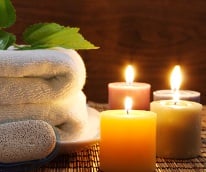Like many people, you may be asking: What makes a candle vegan and cruelty-free? What harmful products are often used in candles?

Shopping for candles, whether to light the table for that special romantic evening, votive candles to float in the bath, or ones to pop in the kitchen drawer just in case the lights go out, means thinking about what goes into them.
The main ingredients to avoid are beeswax, which is stolen from the industrious bees’ hive, tallow (a slaughterhouse product), and paraffin wax, a petroleum product that is associated with health risks. Today, there are wonderful decorative and practical household candles, all easy to find, that are made from soy and other ingredients that are kind to the environment, as well as to your health, and which do not depend on killing and stealing from animals.
According to environmental watchdogs, there are three main reasons to avoid buying petroleum (paraffin) products. These are:
• Petroleum smoke/exhaust contains many carcinogenic toxins and produces ugly black soot
• Petroleum is not a renewable resource and it is of a limited supply
• Burning petroleum products creates air pollution and contributes to global warming
Paraffin candles contain up to 11 carcinogenic compounds which have been deemed “toxic air contaminants” by the State of California. An air quality researcher, David Krause, has documented evidence that candle soot particles contain many of the same compounds given off from burning diesel fuel.
No one really knows when the first candle was invented, but in Roman times candles were made of the pith of certain rushes, peeled except on one side, and dipped in animal fat, so animal fat was always a factor. Today, tallow candles are still made from “rendered” sheep or beef fat from around the cow’s kidneys, so little wonder they can go rancid, can cause irritations in sensitive people, and smell awful once you know exactly what it is your nose is picking up!
A fine alternative to animal tallow is vegetable tallow, a substance resembling tallow, obtained from various plants. Chinese vegetable tallow is obtained from the seeds of the tallow tree, and Indian vegetable tallow is a name sometimes given to piney tallow.
Vegetable wax is also a safe ingredient. This is simply a waxy excretion on the leaves or fruits of certain plants, such as the bayberry.
By the Middle Ages candles were common. Tallow, beeswax, and vegetable wax such as bayberry in North American, candleberry in the East, and waxberry in South America, were later supplemented by whale oil (spermaceti) and by stearine or stearic acid in the early 1800s (this is still obtained from plants which process the carcasses of dogs and cats killed in animal pounds and shelters), then by paraffin in the mid-1800s.
Somewhere along the way, people learned to pour beeswax over the wicks. Here’s why to avoid it:
Whether we are stealing honey, royal jelly, pollen, propolis, or wax from bees, these incredible little insects-capable of complicated communication documented in their dances and of a social network compared to which our most carefully designed modern communities pale, suffer and die quite needlessly.
First, smoke is blown into the bees’ hives to make the bees easier to deal with. Next, a “bee brush” is used to crudely sweep away the bees who rush from the hive and succumb to the smoke. In sweeping them aside, the wire tines break off their legs and wings. Bee farmers then remove the honey and the honeycomb, which is, of course, the hive’s main source of nourishment, and replace it with cheap white sugar. Animal wax used in candles (and certain other products, including some polishes, crayons and lip balms) comes from the honeycomb.
It’s easy to pick out “clean candles” as, usually, candle ingredients are marked on them, but sometimes you do have to poke about a bit or ask sales assistants to call the manufacturer for more details than given on the labels. Instead of beeswax-coated wicks, you can also buy paper, hemp and cotton wicks. Next time you buy or light a candle, you can really shine!






